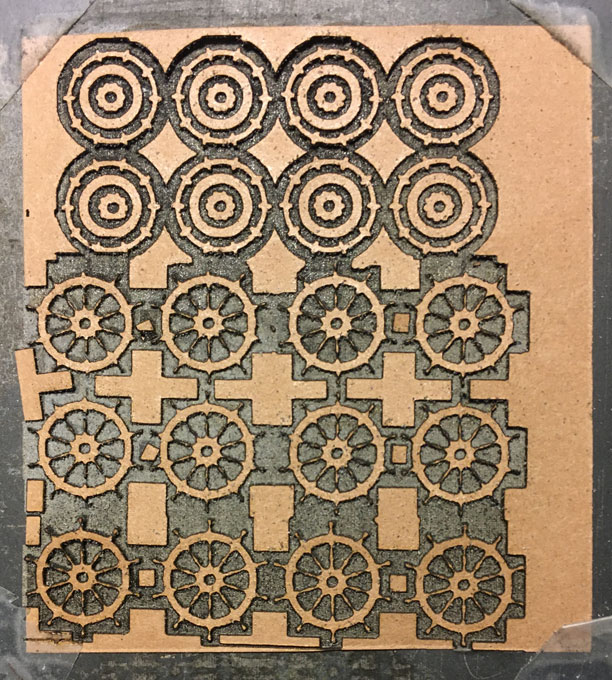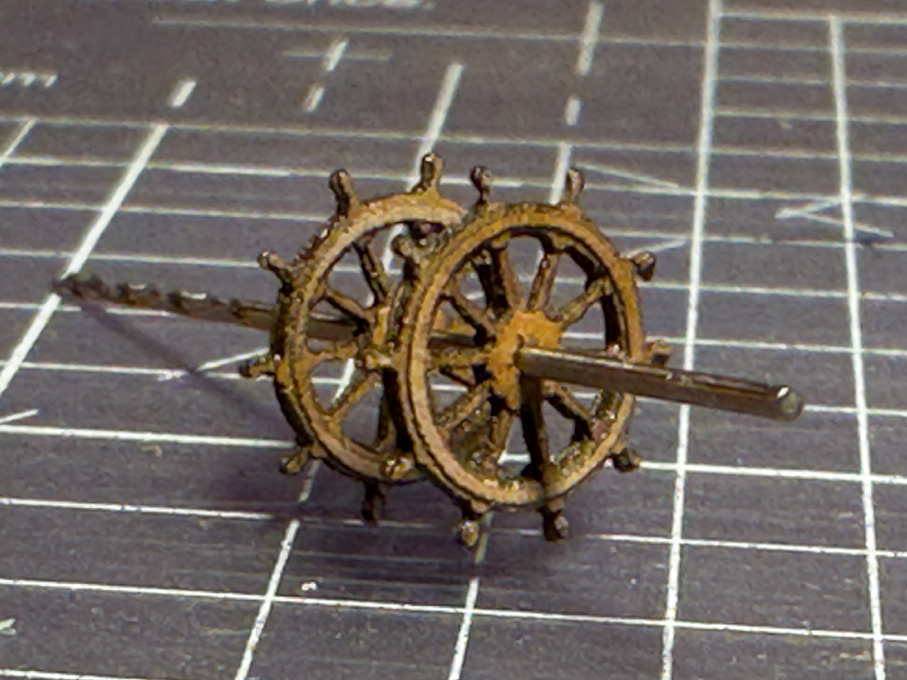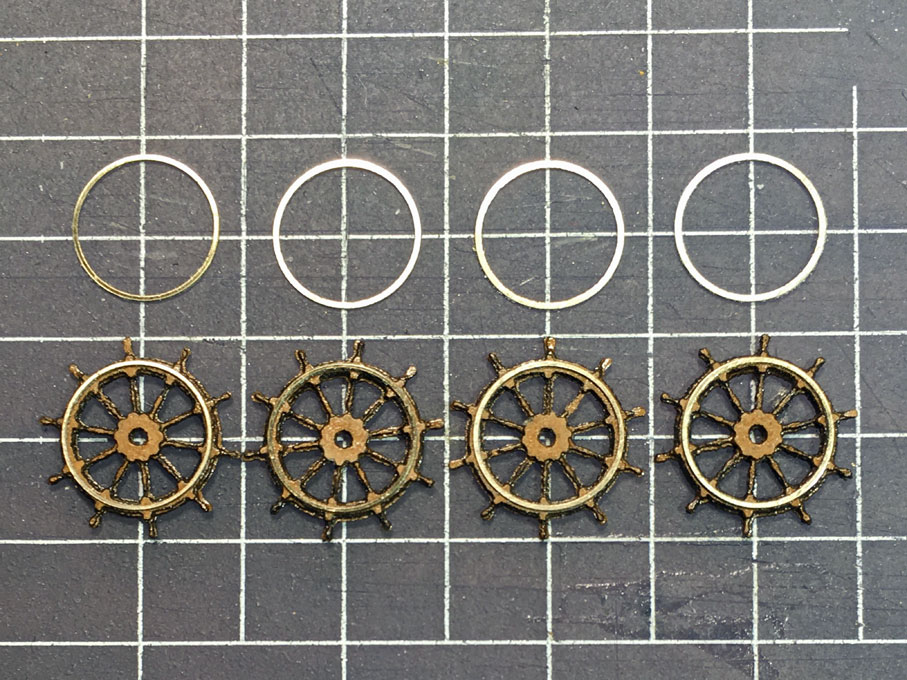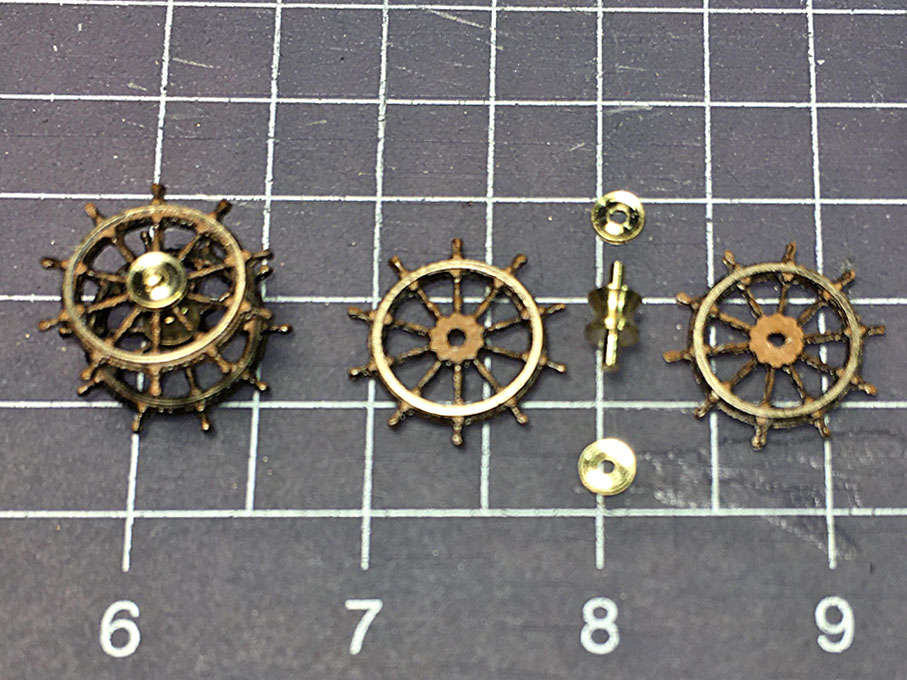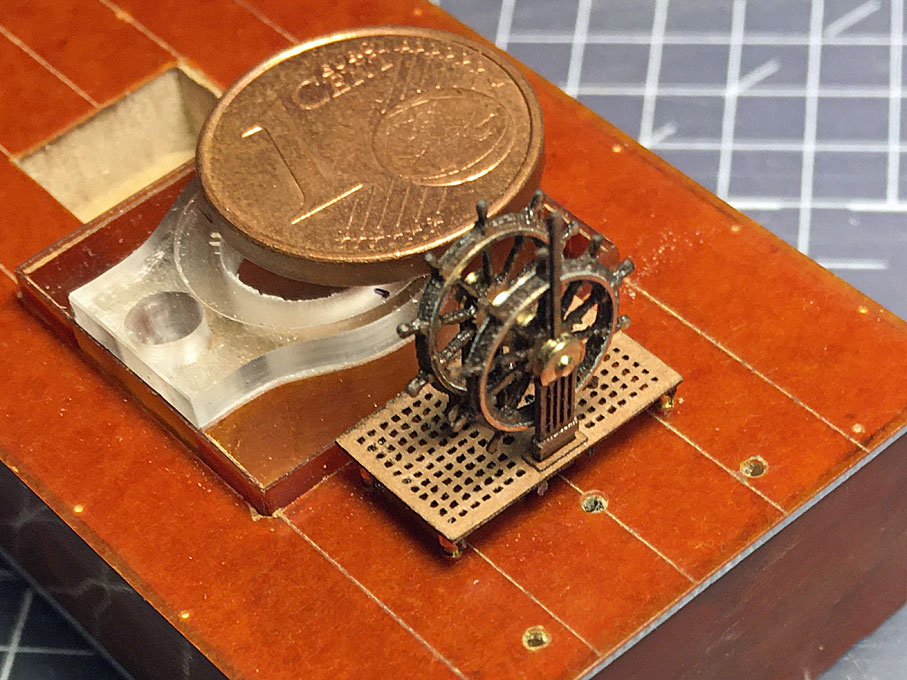Making Miniature Steering-Wheels from Laser-Cut Parts
Wooden steering wheels are complex assemblies,
typically made up of a hub, a rim and the spokes. There may be
metal reenforcing parts that prevent heavily strained parts,
such as the hub, from splitting or keep segments of the rim
together.
The spokes are long, slender items and are usually turned to a decorative profile. Where they meet the rim, they are square in section and fit into the hub with kind of wedge-shaped tangs.
Making such wheels in small scales/sizes, say with less than 10 mm diameter, can be quite a challenge. Here a method is proposed in which the wheels are built up from layers of laser-cut paper.
After some tests with my small 3W laser-cutter, 120 g/m2 weight so-called Canson-paper, which is 0.15 mm thick and has a smooth surface, turned out to be the best choice. It cuts well with this laser-cutter, as it is not ballasted with inorganic material, such as barytes, which do not burn or evaporate. If one has a more powerful laser-cutter and a suitable exhaustion, one may rather work with styrene.
As usual some trials were needed to determine the right cutting parameter combination of contrast, laser-power and cutting depth. The cutting software works with bit-images and one should assume that for a simple B/W-picture the contrast should be 100%, but somehow changing the contrast setting changes the width of the cuts. For this reason, the final dimensions of the parts depend on the contrast setting.
Laser-cutting is contactless and the cut-out parts are not moved during the cutting process. Therefore, it is possible to cut them out completely and in contrast to the photoetch-process they do not need to be attached to some frame.
When designing the image with which the laser-cutter works, one needs to consider all these factors that sometimes can only be determined by trial and error.
The wheels are built up from several layers in order to simulate the joinery work and to arrive at the desired 3D-rendering. Two core parts are thickened by two more layers the outline of which was drawn a bit smaller to simulate the profiling of wheels and handles. A further layer on each side simulates the rim and hub. The individual layers where first thoroughly soaked in fast-drying varnish (Zapon-lacquer), which impregnates and stiffens the cardboard. Then they were sanded smooth using a fine diamond (nail)file. The same lacquer is used to cement the layers together. Unlike many other glues, this lacquer only forms a very thin layer, not adding to the thickness of the material. They are adjusted while the lacquer is still wet and the layers squeezed together. For this, flat tweezer as used by stamp collectors proved very handy. Of course, a piece of wire or a drill of suitable thickness are used as axis during alignment of the layers.
Once completely dry, the wheels are given another coat of varnish as preparation for further shaping. This can be done with very fine and thin watchmaker needle-files. Thus, the spokes and in particular the handles are rounded as much as possible. If necessary, the procedure is repeated after another coat of varnish to prevent the paper from fraying. Building up the spokes from several layers already helped to achieve this effect.
Some steering wheel have brass-rings screwed to the front face of the rim to reenforce it and perhaps also for decorative purposes. While this can be painted on, it looks more realistic, when it is made from real brass (remember: only real metal looks like real metal 😉 ). The obvious way would be to etch these from brass shim – but when going through this process, the whole wheel could have been etched, again in several layers that are then soldered together … Another route would be to cement brass shim-stock with CA glue to a so-called wax-chuck and to cut out the rings on the lathe. Cutting forces are quite high on the soft shim-stock and experience shows that it is not likely to work. A proven third route is to chuck a suitable piece of brass rod into the lathe, turn down the desired outside diameter, bore out the inside diameter and then part off very thin slices with a sharp and narrow parting tool. It is possible to produce a brass tube with 0.3 mm wall thickness and part off rings of 0.1 mm thickness. After a few trials to get the settings right, this will work fast and repeatable and result in undistorted rings. The rings are deburred on 600 grit wet-and-dry paper, ground finely on an Arkansas-stone and polished on a piece of paper with some brass-polishing compound. The brass rings are cemented onto wheels again with lacquer.
The wheel is no ready for painting. An all-wood wheel can be readily spray-painted, but for a wheel with a brass-face rim, I would recommend brush-painting in order to avoid covering the brass in paint. With the brush mishaps can happen, but that little amount of rogue paint can be carefully scraped off with a scalpel. The paint further helps to define the round spokes and extra paint can be added to enhance this. Unfortunately, it often only after the first coat of paint that imperfections become visible. With some extra paint these may be evened out.
The wheel is to be finished with a rope drum, hub covers etc. which are turned from brass rod.
The spokes are long, slender items and are usually turned to a decorative profile. Where they meet the rim, they are square in section and fit into the hub with kind of wedge-shaped tangs.
Making such wheels in small scales/sizes, say with less than 10 mm diameter, can be quite a challenge. Here a method is proposed in which the wheels are built up from layers of laser-cut paper.
After some tests with my small 3W laser-cutter, 120 g/m2 weight so-called Canson-paper, which is 0.15 mm thick and has a smooth surface, turned out to be the best choice. It cuts well with this laser-cutter, as it is not ballasted with inorganic material, such as barytes, which do not burn or evaporate. If one has a more powerful laser-cutter and a suitable exhaustion, one may rather work with styrene.
As usual some trials were needed to determine the right cutting parameter combination of contrast, laser-power and cutting depth. The cutting software works with bit-images and one should assume that for a simple B/W-picture the contrast should be 100%, but somehow changing the contrast setting changes the width of the cuts. For this reason, the final dimensions of the parts depend on the contrast setting.
Laser-cutting is contactless and the cut-out parts are not moved during the cutting process. Therefore, it is possible to cut them out completely and in contrast to the photoetch-process they do not need to be attached to some frame.
When designing the image with which the laser-cutter works, one needs to consider all these factors that sometimes can only be determined by trial and error.
The wheels are built up from several layers in order to simulate the joinery work and to arrive at the desired 3D-rendering. Two core parts are thickened by two more layers the outline of which was drawn a bit smaller to simulate the profiling of wheels and handles. A further layer on each side simulates the rim and hub. The individual layers where first thoroughly soaked in fast-drying varnish (Zapon-lacquer), which impregnates and stiffens the cardboard. Then they were sanded smooth using a fine diamond (nail)file. The same lacquer is used to cement the layers together. Unlike many other glues, this lacquer only forms a very thin layer, not adding to the thickness of the material. They are adjusted while the lacquer is still wet and the layers squeezed together. For this, flat tweezer as used by stamp collectors proved very handy. Of course, a piece of wire or a drill of suitable thickness are used as axis during alignment of the layers.
Once completely dry, the wheels are given another coat of varnish as preparation for further shaping. This can be done with very fine and thin watchmaker needle-files. Thus, the spokes and in particular the handles are rounded as much as possible. If necessary, the procedure is repeated after another coat of varnish to prevent the paper from fraying. Building up the spokes from several layers already helped to achieve this effect.
Some steering wheel have brass-rings screwed to the front face of the rim to reenforce it and perhaps also for decorative purposes. While this can be painted on, it looks more realistic, when it is made from real brass (remember: only real metal looks like real metal 😉 ). The obvious way would be to etch these from brass shim – but when going through this process, the whole wheel could have been etched, again in several layers that are then soldered together … Another route would be to cement brass shim-stock with CA glue to a so-called wax-chuck and to cut out the rings on the lathe. Cutting forces are quite high on the soft shim-stock and experience shows that it is not likely to work. A proven third route is to chuck a suitable piece of brass rod into the lathe, turn down the desired outside diameter, bore out the inside diameter and then part off very thin slices with a sharp and narrow parting tool. It is possible to produce a brass tube with 0.3 mm wall thickness and part off rings of 0.1 mm thickness. After a few trials to get the settings right, this will work fast and repeatable and result in undistorted rings. The rings are deburred on 600 grit wet-and-dry paper, ground finely on an Arkansas-stone and polished on a piece of paper with some brass-polishing compound. The brass rings are cemented onto wheels again with lacquer.
The wheel is no ready for painting. An all-wood wheel can be readily spray-painted, but for a wheel with a brass-face rim, I would recommend brush-painting in order to avoid covering the brass in paint. With the brush mishaps can happen, but that little amount of rogue paint can be carefully scraped off with a scalpel. The paint further helps to define the round spokes and extra paint can be added to enhance this. Unfortunately, it often only after the first coat of paint that imperfections become visible. With some extra paint these may be evened out.
The wheel is to be finished with a rope drum, hub covers etc. which are turned from brass rod.
